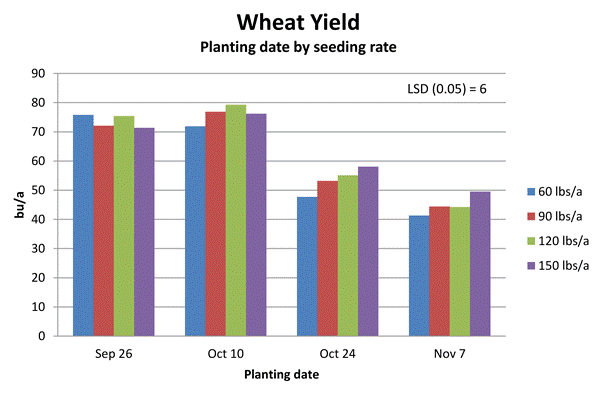By Robert Klein, Extension Western Nebraska Crops Specialist
With weather delays and soybeans maturing late this year, many producers were or will not be able to seed winter wheat at the optimum time for top yields. This includes areas where fields were too moist while other areas were too dry.
The results of research by Kansas State University on seeding dates in northwest Kansas in the Colby area where the optimum seeding date is Sept. 26 are in the figure below. These results show the 4-year average yields for each treatment in the study.
The following conclusions can be made from this study:
- Wheat yields were much higher when planted at the optimal time: Sept. 26 or Oct. 10.
- At the earliest planting date, seeding rate had no effect on grain yield. This is because the plants have plenty of time to tiller, especially at the lower seeding rates.
- At the Oct. 10 planting date, seeding rate did impact yield, with the 120-pounds-per-acre seeding rate yielding more than the 60-pounds-per-acre rate.
Winter wheat seeded late can out-yield winter wheat seeded earlier, especially when compared with wheat planted much before the suggested dates. This yield increase can be attributed to reduced disease and insect problems and the use of extra soil water in the fall.
Recommended Practices When Seeding Wheat Late
You can increase your chance of success by taking these steps when seeding wheat late:
1. Use narrow row spacings.
When seeding after the recommended date, narrow row spacings of 5-8 inches are preferred over wider spacings of 10-15 inches. If you use a wider spacing, such as with a 15-inch seeder, consider seeding twice, with the second pass at a slight angle to the first. Use half the seeding rate each time. This will only work with disc drills; hoe drills move soil and would bury much of the seed from the first pass.
2. Increase the seeding rate.
Late seeding usually results in less root and tiller development. A general recommendation for rainfed wheat is to increase the seeding rate 10-15 pounds (150,000-225,000 seeds) per acre for every week after the suggested seeding date for your area in rainfed wheat. (The maximum seeding rate for rainfed wheat is 120 pounds, or 1.8 million seeds, per acre.)
Another option would be to limit the seeding rate to no more than twice the seeding rate for the recommended date for your area.For irrigated wheat the recommended seeding rate is 90 pounds (1,350,000 seeds) per acre if planted at the suggested seeding date. Increase the seeding rate 15- 20 pounds (225,000-300,000 seeds) per acre for every week after the suggested seeding date to a maximum of 180 pounds (2,700,000 seeds) per acre.
Also, when no-tilling into row crop stubble, seeding rates can be increased by as much as 50%, even when seeded during the suggested seeding dates. When seeding occurs more than 1 week after the suggested seeding date, the rate should be 90-120 pounds (1.35-1.8 million seeds) per acre for rainfed. With irrigated wheat, increase the seeding rate the same up to the maximum listed earlier.
3. Apply phosphorus with the seed.
When seeding wheat late, phosphorus (P) placed with the seed helps improve yield. Use 20 pounds P where none is called for by soil tests and increase other P rates which are over 20 pounds by 20% for late-seeded winter wheat.
The normal superphosphates and ammonium phosphates generally have a negligible effect on wheat stands because of the:
- low salt content of P fertilizers compared to nitrogen (N) fertilizer,
- the low concentration associated with narrow rows (5-12 inches), and
- the generally high rates of seed used.
The seeding mechanism for applying P fertilizer with the seed is not critical unless the grower applies additional N at the same time. Do not apply over 15-20 pounds of N per acre with the seed. Also, do not use 12-0-0-26.
If equipment is not available to place fertilizer in the seed furrow, 11-52-0 or 18-46-0, can be mixed with the winter wheat seed. A good mix is important and fertilizer dealers can usually do this for you. I prefer to use 11-52-0 with its lower N content.
With this method, check to see if you are satisfied with the mix by test drilling on top of the ground so you can observe how well the winter wheat seed and fertilizer are mixed. Be aware that with this method, the fertilizer may cause more wear to the drill. Also, fertilizers can absorb water, so take precautions against this.
4. Use certified treated seed to increase seeding success.
The seed treatments need to thoroughly coat the seeds to give good results and should be applied with quality seed-treating equipment.






Post a comment
Report Abusive Comment